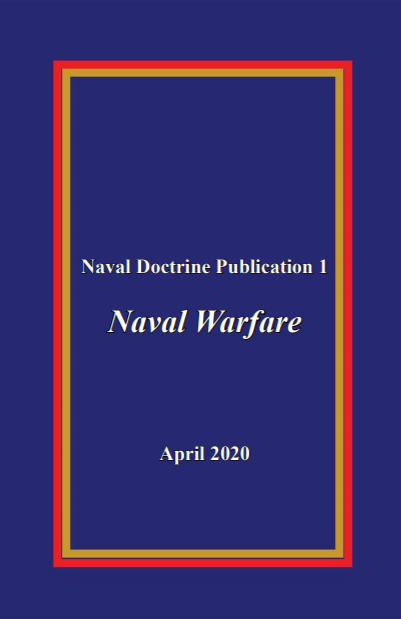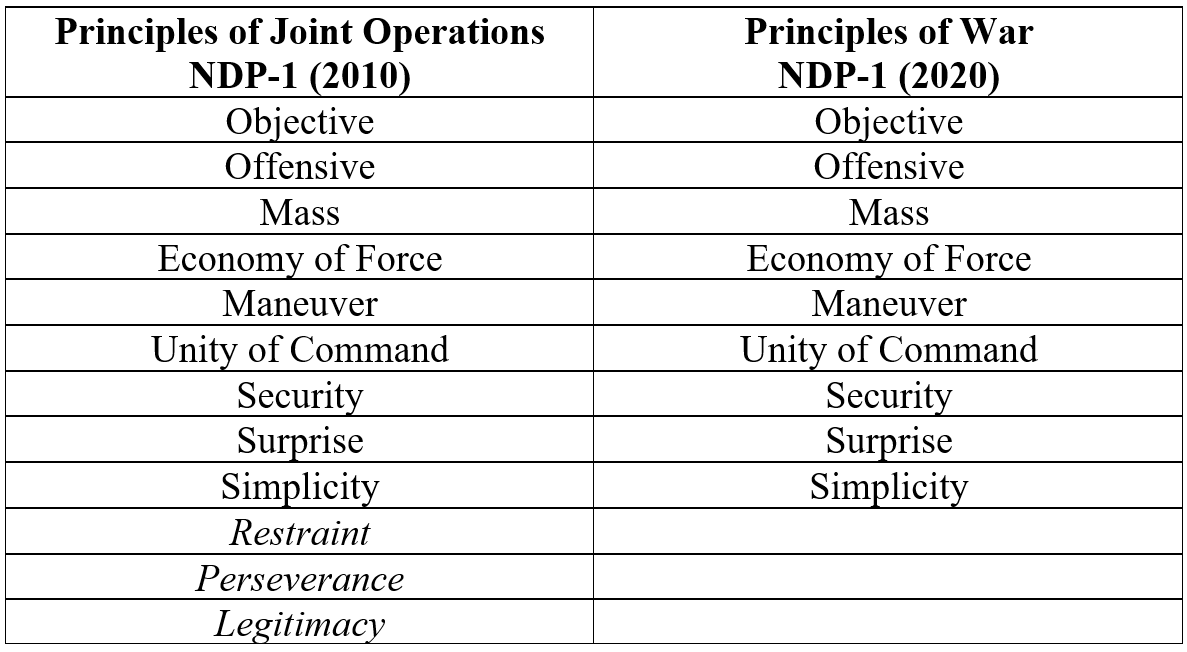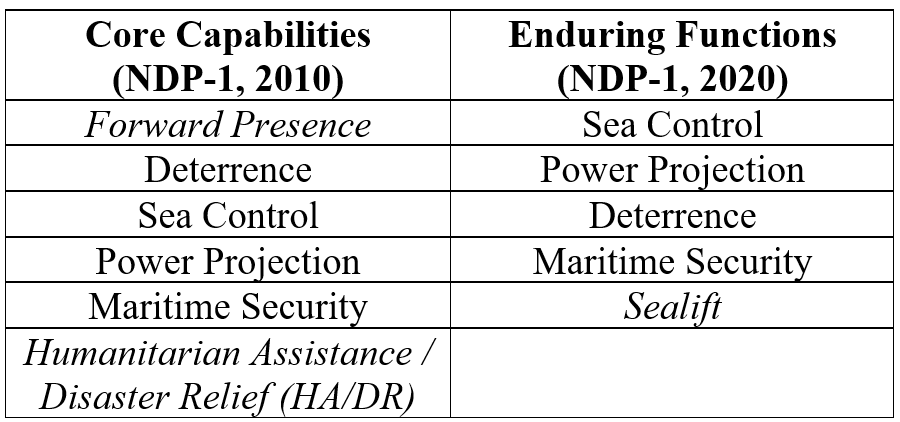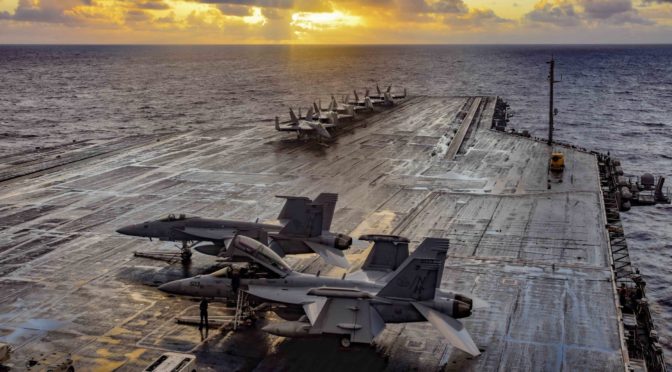By Jimmy Drennan
Introduction
An analysis of warfighting trends over a decade could be performed by considering the major crises, conflicts, and tensions that took place, or by tracking the evolving force structure and operating concepts of global competitors. Alternatively, one could compare foundational documents issued over that same timespan. In April of this year, the U.S. Navy, U.S Marine Corps, and U.S. Coast Guard (collectively, the U.S. Naval Service) jointly published the latest version of Naval Doctrine Publication 1: Naval Warfare, superseding the previous version released in 2010. The difference between the two documents is stark, and indicates a change over the last ten years in the way the United States views naval warfare – simultaneously reaching back to its historical roots, while also looking over the horizon to future conflicts.
This analysis compares NDP-1 (2010) and NDP-1 (2020) to reveal the major differences in content, style, and tone, and what those difference might imply for the U.S. Naval Service’s strategic direction. In addition to a clear focus on American naval history, readers will notice a shift from contributing to the joint force of all military branches to emphasizing the singular importance of American seapower. In fact, NDP-1 (2020) replaces the Naval Service’s six core capabilities with five enduring functions, elevating the role of sea control and sealift, while diminishing the importance of forward presence and humanitarian assistance and disaster relief operations (HA/DR).
Quality of Writing
First and foremost, NDP-1 (2020) is eminently more readable than its predecessor. Both documents are intended to be read by every Sailor, Marine, Coast Guardsman and woman, and civilian in the U.S. Naval Service. However, NDP-1 (2020) seems to recognize that a large portion of that audience is not a regular consumer of military doctrine. NDP-1 (2010) is written in language that nests well with the doctrine of any branch of the U.S. Armed Forces (more on this later), but not in language that would help a novice understand why the U.S. Naval Service is important and unique, and how it should be employed. In fact, the language of the sea (nautical lexicon, not necessarily jargon) is noticeably absent from NDP-1 (2010), the doctrinal foundation of a seagoing service whose traditions and culture pre-date the U.S. Armed Forces. For example, the phrase “command of the seas” does not appear in NDP-1 (2010), while it is introduced up front in NDP-1 (2020) as “a fundamental strategic pillar of our nation, necessary for the security and prosperity of our citizens.”
NDP-1 (2020) makes a concerted effort to plainly demonstrate the value of American seapower. Whereas NDP-1 (2010) liberally uses military doctrine buzzwords and acronyms, NDP-1 (2020) instead describes similar concepts in plain language that helps the reader understand the nature and character of the U.S. Naval Service. NDP-1 (2010) is littered with joint terms like DIME, DOTPLMF, ROMO, PMESII, and JIPOE. In parts, it could be easy to forget which service the document was written for.1 NDP-1 (2020) dispenses with such language, and other doctrinal hallmarks like pages labeled “INTENTIONALLY BLANK,” instead utilizing an almost narrative prose, making good use of illustrations, quotations, and vignettes without distracting the reader. NDP-1 (2010) is focused on describing the current manifestation of naval operations, which in 2010 were largely in support of joint campaigns on land, or otherwise concerned with the lower end of the warfighting spectrum. NDP-1 (2020), however, focuses on the theory and principles of naval warfare and their potential future application, irrespective of current operations, adroitly observing “the interlude from great power competition is over.”2
Aside from commending the  authors for distilling such a broad and complex topic for a large audience, there is another important reason why the quality of writing in NDP-1 (2020) is worth mentioning. Since the U.S. Naval Service is entering an era in which high-end combat at sea is entirely imaginable (something that could not be said in 2010), it seems plausible the document was written with another audience in mind: Congress. One reason for writing doctrine that can be easily digested is to craft a story that helps non-navalists understand the logic behind budget requests. If NDP-1 can show those outside maritime circles why American seapower is necessary, and how the naval service is unique, it can serve as a foundation not just to operational doctrine, but also to programming and budgeting. If the Naval Service’s future success depends upon arguing for a larger portion of defense budgets, the integration of force generation and force employment strategies based on a single conceptual foundation is paramount.
authors for distilling such a broad and complex topic for a large audience, there is another important reason why the quality of writing in NDP-1 (2020) is worth mentioning. Since the U.S. Naval Service is entering an era in which high-end combat at sea is entirely imaginable (something that could not be said in 2010), it seems plausible the document was written with another audience in mind: Congress. One reason for writing doctrine that can be easily digested is to craft a story that helps non-navalists understand the logic behind budget requests. If NDP-1 can show those outside maritime circles why American seapower is necessary, and how the naval service is unique, it can serve as a foundation not just to operational doctrine, but also to programming and budgeting. If the Naval Service’s future success depends upon arguing for a larger portion of defense budgets, the integration of force generation and force employment strategies based on a single conceptual foundation is paramount.
Historical Perspective
Out of the gates, NDP-1 (2020) clearly establishes a connection to American naval history. Before reaching “page 1,” the reader finds quotations from Raymond Spruance, John Adams, and Harry E. Yarnell, and a vignette from James D. Hornfischer’s The Last Stand of the Tin Can Sailors.3
Continuing the historical theme, NDP-1 (2020) includes quotations from prominent American naval leaders, strategists, and theorists, with a particular emphasis on Alfred Thayer Mahan. In fact, Mahanian influence in the document is evident not just in quotations, but also in its central premise that the ultimate purpose of the U.S. Naval Service is to achieve command of the seas. NDP-1 (2020) echoes Mahan’s notion that America is inherently a maritime republic, and its prosperity depends upon achieving command of the seas through seapower. Similarly, NDP-1 (2020) bluntly states that sea control (a localized, temporary version of command of the seas) “enables all other naval functions.” In contrast to their predecessors, the authors of NDP-1 (2020) were clearly writing doctrine for a Naval Service prepared for the full range combat operations at sea. And if the authors truly did intend to speak to Congress, it is not surprising they chose to highlight Mahan who was, besides being widely considered one of America’s greatest strategists, a vocal advocate for large fleets and vibrant shipping and shipbuilding industries.
Next to Mahan, the other most noticeable historical emphasis in NDP-1 (2020) is on World War II. Starting with Hornfischer’s vignette on Taffy Three’s heroics at Leyte Gulf, it draws upon the legacy of the last war that saw major, sustained naval combat, with quotes from icons like Nimitz, King, Burke, and Spruance. There is even an entire section dedicated to the lessons on fleet operations offered by the campaigns in the Atlantic and Pacific, the former being cumulative and in support of a land campaign, and the latter being sequential in nature in a principally maritime theater. On this last point, one hopes the Naval Service does not lean too heavily on historical precedent. While the geography of the next major war in the Pacific could closely resemble the last, its character and conduct will likely not.
NDP-1 (2020) includes dozens of quotations from prominent figures in American naval and national history like George Washington, John Paul Jones, John Lejeune, Samuel P. Huntington, and Wayne Hughes. In fact, of all the quotations in the document, the only non-Americans quoted are Carl von Clausewitz, Sun Tzu, Horatio Nelson, Julian Corbett, and Winston Churchill – all of whom have had a significant influence in shaping American naval warfare. Conversely, of the only four people quoted in NDP-1 (2010), one was an ancient Greek general and one was a currently-serving U.S. general. Even considering the undeniable popularity of then-General Mattis and his knack for memorable one-liners, in retrospect this seems like a poor choice.
Joint Force versus Seapower
“The Navy, Marine Corps, and Coast Guard team is relevant today and in the future because of its ability to contribute to the joint force in achieving [strategic] objectives. –NDP-1 (2010)
While the theme of NDP-1 (2020) is the importance of American seapower, the theme of NDP-1 (2010) was more focused on how the Naval Service fits into the larger Joint Force. As mentioned earlier, NDP-1 (2010) was written with an emphasis on the version of naval warfare being exercised at the time, which in 2010 was predominantly aircraft carrier-based power projection in support of wars in Iraq and Afghanistan, counterpiracy operations in the Somali Basin, and responding to natural disasters such as the 2010 Haiti earthquake. Counterpiracy and humanitarian assistance/disaster relief (HA/DR) operations are at the low end of the range of military operations and are almost exclusively the purview of the Naval Service. They also did not contribute directly to the U.S. military’s main effort in the first decade of the 21st century: the defeat of violent extremism in the Middle East. Accordingly, there was a significant push within the Navy and Marine Corps to contribute to joint, land-based operations. The Marine Corps reformed itself to help the Army seize and occupy territory in Iraq and Afghanistan. The Navy sent thousands of “individual augmentee” Sailors to support the Army, and restructured its force employment models to provide U.S. Central Command with continuous presence of at least one, sometimes two, Carrier Strike Groups. The Navy even created blue camouflage uniforms for a more modern, tactical appearance to align with Army and Air Force fatigues. Meanwhile, the Coast Guard shifted wholesale from the Department of Transportation to the new Department of Homeland Security, established in 2002 in the wake of 9/11.
The importance of “jointness” in the early 2000s is evident in NDP-1 (2010). Aside from the liberal use of joint military doctrine buzzwords and acronyms, it takes great pains to describe how the Naval Service nests within joint doctrine and policy, beginning in the first paragraph of the introduction. NDP-1 (2010) carefully defines each key term by its joint definition, citing the appropriate joint publication. Even inherent naval terms, such as “maritime domain” and “maritime power projection,” are referenced to joint publications, almost as though it would not have been appropriate for NDP-1 to be the authoritative document for such terms. On the contrary, NDP-1 (2020) relegates the references to joint publications to footnotes and the glossary, indicating an apparent willingness by the authors to offer the document as a primary source which joint doctrine can draw upon for naval warfare concepts.
The reduced emphasis of “jointness” in the Naval Service from 2010 to 2020 is highlighted by two notable examples in NDP-1. First, NDP-1 (2020) lists the nine principles of war as opposed to the 12 principles of joint operations, as in NDP-1 (2010). The difference between the two sets of principles is the inclusion of restraint, perseverance, and legitimacy in the principles of joint operations, which were added as a result of costly lessons the U.S. military learned in the early 2000s. NDP-1 (2020) certainly does not exercise the authority to suggest that the Joint Force abandoned these three modern principles. Rather, NDP-1 (2020) simply indicates it was more valuable to include the principles of war vice the principles of joint operations. The reason for the change is not given, but it does fit with the trend of de-emphasizing “jointness” and refocusing on the enduring nature of naval warfare.

The second key example of NDP-1 (2020) moving away from a focus on joint operations is the absence of any discussion on the six phases of a joint campaign. On the other hand, NDP-1 (2010) devotes the last seven pages to describing the six phases (Shape, Deter, Seize the Initiative, Dominate, Stabilize, Enable Civil Authority). Within each phase, there is a description of how naval activities and operations can be incorporated into the larger joint effort. Over the past two decades, the joint phasing construct became so central and ubiquitous in military planning that it can be difficult to conceive an operation without phases. NDP-1 (2020) instead describes “operations along the competition continuum.” The competition (or competition-conflict) continuum does not necessarily appear intended to replace the joint phasing construct. Rather, the continuum is used to conceptually bridge steady-state, daily operations with the highest imaginable end of naval combat. Conversely, the use of campaign phases can inadvertently cause military leaders, strategists, and planners to falsely envision operations as discrete, isolated events with clearly delineated beginnings and endings. As NDP-1 states, “Our ability to maintain and execute naval functions throughout the competition continuum generates the ability to influence world events. Fundamentally, our ability to influence depends upon our ability to prevail in armed conflict.” Here again, no explanation is given in NDP-1 (2020) for excluding campaign phases, nor does it indicate the Joint Force has abandoned the phasing construct. However, the use of the competition continuum indicates strong influence from the concept of “gray zone” warfare and the prevailing focus on “great power competition,” in which military confrontation can be ambiguous and fluid.
A final note on “jointness:” for all the momentum evident in NDP-1 (2020) toward establishing the independent importance of American seapower, the U.S. military still fights as an integrated joint force. Global operations are commanded by combatant commanders, who wield functional components from all military services in a variety of ways to accomplish their mission. Rarely does the Naval Service secure national interests on its own. Even U.S. Indo-Pacific Command, a distinctly maritime theater typically commanded by an admiral, cannot neglect the contributions of the Army and Air Force in preserving the international rules-based order. Perhaps this is why NDP-1 (2020) distills the entire discussion on maritime strategy down to a single sentence: “Thus, maritime strategy boils down to this: What can the Naval Service do to best help our nation achieve what it needs across this [competition] continuum?”4 This indicates a solid recognition that naval operations support national strategy, and could even imply that single-domain strategies are unnecessary in a military that fights as an integrated joint force.
On the same token, it is unfortunate that NDP-1 (2020) does not mention the new joint concept of Dynamic Force Employment (DFE), a model for employing the joint force with agility and unpredictability. DFE could significantly impact how the Naval Service is used as an instrument of national power, as deployments will see much less geographic and temporal regularity. Even though it is a joint concept, one would think a Naval Service looking to recoup strategic readiness – and apparently de-emphasizing “forward presence” (more on that next) – would embrace DFE, yet the Naval Service continues to ignore the concept in its own doctrine, missing the opportunity to shape the concept in its favor.
From Core Capabilities to Enduring Functions
The most consequential difference between the 2010 and 2020 versions of NDP-1 lies in the way the two documents outline how the Naval Service secures U.S. national interests. NDP-1 (2010) defines six core capabilities, whereas NDP-1 (2020) defines five enduring functions.

While the two lists are similar, the obvious difference is that HA/DR and forward presence are not listed as enduring functions, whereas sealift is. The shift from core capabilities to enduring functions actually began with the revision of A Cooperative Strategy for 21st Century Seapower in 2015. In 2007, the original strategy expanded the traditional four core capabilities to include HA/DR and maritime security. In 2015, the revised strategy replaced the core capabilities with five essential functions, which closely resemble the enduring functions in NDP-1 (2020), including “all domain access” instead of sealift. This was likely in response to China’s anti-access/area denial (A2/AD) strategy and in recognition of the need for freedom of action in the electromagnetic (EM) spectrum.
The choice to establish five enduring functions in NDP-1 (2020) is noteworthy for a few reasons. First, the removal of HA/DR implies that it is no longer viewed as important as sea control, power projection, deterrence, and maritime security. This aligns with the trend of moving away from missions that do not directly support command of the seas. Second, the addition of sealift implies a renewed appreciation of the importance of maritime logistics in naval warfare (all warfare overseas, in fact). It is no secret that the Naval Service neglected its merchant marine fleet over the past decade. Maritime Administrator Mark Buzby recently noted the U.S. would need about 50 more merchant vessels and about 1800 Merchant Mariners to sustain sealift operations in a Pacific conflict. Meanwhile, the ships in the fleet average 45 years-old. In a short notice exercise last year, only 40 percent of the Maritime Ready Reserve Fleet was able to sail within 48 hours. In crafting a coherent story to convey the importance of American seapower to Congress and the American public, sealift should be a central theme and is appropriately included as an enduring function of the Naval Service.
Finally, maritime security (another 2007 addition alongside HA/DR) was retained, while forward presence was removed. The implication is that achieving maritime security is more important than maintaining forward presence. This is peculiar, particularly since NDP-1 (2020) concludes with the phrase “Always forward. Always faithful. Always ready. Always.” Instead of being listed as an enduring function, forward presence is described as supporting deterrence, naval diplomacy, and maritime domain awareness. It is possible this is a tacit recognition that forward presence remains important, but the Naval Service cannot sustain routine force deployments as an intrinsic measure of effectiveness. If so, the authors of NDP-1 (2020) missed a key opportunity to embrace Dynamic Force Employment as a viable way to secure national interests while also generating readiness for future conflicts.
Conclusion
Ultimately, the value in comparing NDP-1 (2020) with NDP-1 (2010) lies in identifying trends in how the Naval Service wages war, so those who implement strategy can adapt accordingly, and in highlighting possible issues, those who craft strategy can also adjust course as needed.
The first noteworthy trend is the overall improvement of the document itself. The quality and style of writing in NDP-1 (2020) is apparent, and bodes well for reaching a broader audience, beyond those who read doctrine as part of their occupation. NDP-1 (2020) goes a long way toward telling a story of the importance of American seapower. A compelling story, or logical narrative, is crucial for making convincing budgetary arguments to non-navalists in the Pentagon and in Congress.
The second trend is the renewed emphasis on the history of American seapower. Whereas NDP-1 (2010) was focused on seapower as it was being applied at the time, NDP-1 (2020) firmly establishes the Naval Service’s historical roots, and demonstrates how the lessons of the past could be applied today and in the future. The caution for strategists is not to draw too heavily on the lessons of the last major naval conflict in the Pacific. One of the only certainties in warfare is that it tends to unfold in unexpected and surprising ways. As the prospect of high-end naval warfare in the Pacific is once again visible on the horizon, it is entirely possible the list of similarities with World War II may end with geography.
The third trend is the shift from describing the Naval Service as part of a larger joint force, to focusing on how the Naval Service itself secures national interests. NDP-1 (2020) does not abandon the idea of the Naval Service supporting the joint force, but it certainly focuses more on naval warfare and less on joint operations. On the other hand, NDP-1 (2010) was written with such an emphasis on “jointness” that it might have been more appropriately titled Naval Contributions to Joint Operations instead of Naval Warfare. The caution for strategists here is, with the renewed emphasis on communicating the importance of American seapower, not to become too myopic and forget the critical contributions and interrelationships of all military branches.
Finally, the most consequential trend is the change from six core capabilities to five enduring functions (seapower, power projection, deterrence, maritime security, and sealift). The removal of HA/DR and forward presence signals that the Naval Service no longer views these functions as central to accomplishing its mission, whereas the inclusion of sealift signals a recognition of the criticality of maritime logistics. As opposed to the Principles of Joint Operations, NDP-1 (2020) does have the authority to officially redefine the Naval Service’s core capabilities into enduring functions, so this particular change merits more discussion and explanation.
Specifically, leaders should explain the logic behind not including forward presence as an enduring function. It could be that the Naval Service no longer views forward presence as a function at all, but rather as a characteristic that supports other functions. As the Naval Service struggles to build an integrated force structure that can keep up with global commitments and threats, forward presence as it was previously understood may have been unsustainable to include as an enduring function. If so, the Naval Service would do well to incorporate the joint concept of Dynamic Force Employment into its evolving narrative on the importance of American seapower in securing national interests.
Endnotes
1. NDP-1 (2010) uses the phrase “political, military, economic, social, infrastructure, and information” but thankfully refrains from using the actual acronym.
2. Some use of the buzz phrase “great power competition” is unavoidable and forgivable. NDP-1 (2020) manages to successfully ponder naval warfare in this future geopolitical schema without overusing the term to the point of cliché.
3. Admiral Yarnell demonstrated the vulnerability of Hawaii to Japanese air attacks via fleet exercises conducted as part of joint Army/Navy war games in 1932, a decade before the attack on Pearl Harbor.
4. For comparison, NDP-1 (2010) devotes three full pages to an explanation of A Cooperative Strategy for 21st Century Seapower, the unified maritime strategy of the Naval Service.
5. Capabilities and functions are listed as ordered in each version of NDP-1.
Featured Image: PHILIPPINE SEA (June 1, 2020) The aircraft carrier USS Theodore Roosevelt (CVN 71) transits the Philippine Sea, June 1, 2020. (U.S. Navy photo by Mass Communication Specialist 3rd Class Julian Davis/Released)


I suppose semantics are especially important in military jargon, and personnel remember better with simplicity of purpose.
I find “combined ” better than “joint” for example, and there is often too much verbosity in the instructions and principles needed for personnel to imbibe:)
Combined is used specifically for a multi-national command while joint is used specifically for a multi-service command.
There is a Joint doctrinal foundation for the apparent NDP-1 shift away from the six-phase construct. NDP-1’s citation of Joint Doctrine Note (JDN) 1-19, “Competition Continuum” is significant, as JDN 1-19 (pg5) suggests the phases have had limited utility in real-world applications and are ill-suited to the new concept of Joint campaigning. More notably, the 2017 JP 5-0 “removes the six-phase phasing model, but does not change the definition of phases or the use of phasing as a planning tool.” In other words, the phasing construct seemingly shifts from being the doctrinally mandated template for campaign design to something more akin to a teaching aid.
Superb Analysis by Jimmy Drennan. I am VERY encouraged with the new and long-awaited focus for the Sea Services in NDP-1 (2020) ! It is about time and sorely needed.